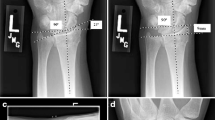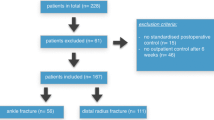Abstract
Purpose
Intraoperative precise visualization of fractures and assessment of the quality of reduction is essential in orthopedic trauma surgery. Fluoroscopic skills will lead to an increased detection rate of minimal abnormalities needing revision intraoperatively. The definition of fluoroscopic skills and the interpretation of acceptable “minimal abnormalities” remains somehow unclear. The purpose of this study was to analyze the subjective quality assessment of intraoperative radiographs (IR) and whether they are influenced by cultural and demographic factors. Furthermore, we aimed to answer the question whether the indication for revision surgery is international comparable or rather influenceable by cultural aspects.
Methods
Intraoperative radiographs of 30 patients operated for an ankle or radius fracture were selected for an international survey. In total, 22 patients were randomly selected from an already existing database and eligible for inclusion if reduction was accomplished during initial operation without planed revision. Eight patients of this group had undergone an unplanned revision surgery (26.6%). Fifteen orthopedic trauma surgeons from three different countries answered this survey. All raters were senior consultants.
Results
The quality of reduction was rated as good in both the AP (7.95 of 10) and lateral (7.84 of 10) views. The inter-observer reliability was substantially weaker in Country B (kappa of 0.23) compared to Countries A (p value < 0.05) and C (range 0.33–0.43). In only 33% of the cases the raters requested a postoperative radiograph. This was significantly fewer (p value < 0.001) in Country A. The frequency of postoperative requested CT’s was comparable between the countries.
Conclusion
This study showed acceptable IR assessment in terms of quality rating. Furthermore, it revealed substantial differences in the postoperative decision-making process in different countries, especially regarding the necessity for postoperative radiographs. This suggests that definition for indication of revision surgery is culturally influenced.


Similar content being viewed by others
References
Bahari S, et al. Radiation exposure of the hands and thyroid gland during percutaneous wiring of wrist and hand procedures. Acta Orthop Belg. 2006;72(2):194–8.
Botchu R, Ravikumar K. Radiation exposure from fluoroscopy during fixation of hip fracture and fracture of ankle: effect of surgical experience. Indian J Orthop. 2008;42(4):471–3.
Bott OJ, et al. Informatics in radiology: use of a C-arm fluoroscopy simulator to support training in intraoperative radiography. Radiographics. 2011;31(3):E65–75.
Brunner A, et al. The dorsal tangential X-ray view to determine dorsal screw penetration during volar plating of distal radius fractures. J Hand Surg Am. 2015;40(1):27–33.
Fleiss JL. Measuring nominal scale agreement among many raters. Psychol Bull. 1971;76.5(1971):378.
Harish S, Vince AS, Patel AD. Routine radiography following ankle fracture fixation: a case for limiting its use. Injury. 1999;30(10):699–701.
Landis JR, Koch GG. The measurement of observer agreement for categorical data. Biometrics. 1977;33(1):159–74.
Manaster BJ, Olmsted WW. Editor's page: the 2000 RadioGraphics monograph issue: musculoskeletal imaging. Radiographics. 2000; 20 Spec No: S1–2.
Marmor M, et al. Limitations of standard fluoroscopy in detecting rotational malreduction of the syndesmosis in an ankle fracture model. Foot Ankle Int. 2011;32(6):616–22.
Medoff RJ. Essential radiographic evaluation for distal radius fractures. Hand Clin. 2005;21(3):279–88.
Oehme F et al. Is there a need for standardized postoperative radiographs after operative treatment of wrist or ankle fractures? Eur J Trauma Emerg Surg. 2018;45(6):1039–44.
Okanobo H, et al. Simplified diagnostic algorithm for Lauge–Hansen classification of ankle injuries. Radiographics. 2012;32(2):E71–84.
Quah C, et al. The effect of surgical experience on the amount of radiation exposure from fluoroscopy during dynamic hip screw fixation. Ann R Coll Surg Engl. 2017;99(3):198–202.
Rikli D, et al. Optimizing intraoperative imaging during proximal femoral fracture fixation—a performance improvement program for surgeons. Injury. 2018;49(2):339–44.
Tufescu T. Working toward reducing postoperative fracture radiographs: a survey of Canadian surgeons. Can J Surg. 2016;59(1):26–8.
von Elm E, et al. The Strengthening the Reporting of Observational Studies in Epidemiology (STROBE) statement: guidelines for reporting observational studies. J Clin Epidemiol. 2008;61(4):344–9.
Weil NL, et al. WARRIOR-trial - is routine radiography following the 2-week initial follow-up in trauma patients with wrist and ankle fractures necessary: study protocol for a randomized controlled trial. Trials. 2015;16:66.
Acknowledgements
We would like to acknowledge Nausicaa Ruzza, Christian Michelitsch and Jörg Winkler.
Author information
Authors and Affiliations
Corresponding author
Ethics declarations
Conflict of interest
F. Oehme, K. Schütze, B.C. Link, H. Frima, T. Schepers, S. Rhemrev, M. Rickman, R. Babst and F.J.P. Beeres declare that there is no conflict of interest regarding the publication of this article.
Rights and permissions
About this article
Cite this article
Oehme, F., Schütze, K., Link, B.C. et al. Perception of quality of intraoperative fluoroscopy and the influence on postoperative management: an international survey. Eur J Trauma Emerg Surg 47, 1073–1079 (2021). https://doi.org/10.1007/s00068-019-01286-z
Received:
Accepted:
Published:
Issue Date:
DOI: https://doi.org/10.1007/s00068-019-01286-z




